The 2004 Suzuki Verona Mid-Size Economy Sedan
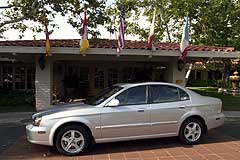
Base MSRP Range: $16,499 - $19,499
Base Invoice Range: Not Available
MSRP As Tested: Not Available
Versions: S, LX and the EX
Vehicle Category: Mid-Size Economy Sedan
Engine Location: Front Engine
Drive Wheels: Front-Wheel Drive
Engine As Tested: 2.5-liter, Dual Overhead Cam, 24-valves, I-6 cylinder, 155-horsepower at 5,800rpm and 177 lb-ft torque at 4,000 rpm.
Transmission As Tested: Standard 4-Speed, Automatic.
Fuel Economy (city/hwy): 20 /2 8
Standard Safety Features: Driver and front passenger airbags, power-assisted disc brakes, ">Antilock Braking System (ABS).
Competition: Hyundai Sonata, Kia Optima, Nissan Altima, Toyota Camry, Honda Accord, Vokswagen Jetta, Mazda 6, Mitsubishi Galant
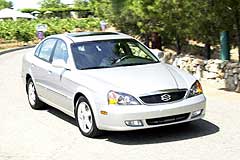
The 2004 Suzuki Verona represents some vehicle firsts for Japanese automaker Suzuki. The Verona is Suzuki's first entry into the highly-competitive, mid-size, economy sedan market. It is the first sedan they have offered with a 6-cylinder engine as a standard feature. It is also the company's first product manufactured outside of Japan, as it will be assembled in Korea at a General Motors Daewoo Automotive Technology (GMDAT) plant.
The General Motors Daewoo Automotive Technology group - which is what Daewoo Motors became when GM bought up the remnants of the company - will manufacture Verona.
The Verona was originally designed to replace the Daewoo Leganza in that company's line. When GM bought Daewoo's assets, Suzuki benefited by absorbing the two new cars Daewoo had in development. One was the car that became the Suzuki Verona. The other was a smaller car designed to compete in the premium, compact car market. It is now a Suzuki product called Forenza, which will be launched in the fall of 2003.
Verona is aimed at Honda Accord and Toyota Camry buyers. More than likely it will be purchased by people who might otherwise buy a Hyundai Sonata, Nissan Altima or Kia Optima. These are customers who want a new car but are very price conscious. As all of these cars have moved up scale a bit, the competition is getting hot.
Suzuki has high hopes the Verona and Forenza will help fuel significant growth for the company. Suzuki plans to triple sales in the United States by 2007. This will be a tall order for them given their sluggish sales of the past.
However that level of growth is possible with the introduction of competitive products and a comprehensive marketing plan. Verona has features that are superior to its competition including both the interior and exterior styling - definitely better than Sonata or Optima. And the starting price is only $16,499.
The Suzuki Verona is offered in three trim levels, the entry-level S with a MSRP of $16,499, the mid-level LX starting at $17,799 and the EX with an MSRP of $19,499 is to be Suzuki's new flagship in the car line. For the moment Verona is the value leader in the segment. If they can do the same with Forenza, they might just accomplish their growth goals.
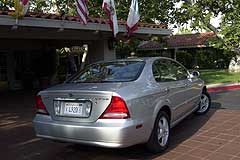
Exterior Styling
The minute we saw the Verona we recognized its Daewoo heritage. That is not a bad thing. The car was designed in Italy, by Italdesign. This company has designed cars for Ferarri, Alfa Romeo as well as Daewoo. They also designed the Volvo Safety Concept Car.
If you have traveled to Italy in recently, you may have been surprised by Daewoo's presence there. There the company has been a major automotive success, rather than a dismal failure as it has been in the US. In Italy Daewoo is successful, in part, because of its great styling. And Italians know good styling when they see it. The fact that the Verona began life as a Daewoo is not something to hold against it. It's a plus.
On the front of the Verona there is large grill and an opening on the top of the bumper with a large S and a chrome accent around it - it is easy to imagine this with the Daewoo grill and logo. Contour lines run from the center-top of the grill toward the windshield and then outward.
The dual, front headlights and turn-signal indicator lights are incorporated into a single piece. They are nicely shaped with a little crease running rearward along the top of the front fenders to the A pillar.
A high beltline ridge begins over the front wheel wells, continuing through the door handles and ending at the rear taillights.
A feature not seen enough these days, are body colored integrated door guards. On the Verona they are accented nicely with chrome on the front and rear doors. The rear license plate holder also has matching chrome accents all around.
The taillight treatment is reminiscent of that on the current Honda Civic with large, semi-triangular, red lenses.
While the styling of Verona is not groundbreaking, it is attractive. There are no strange design cues compromising the look of the car. Unlike the Aerio, Verona is handsome, just not flashy. It's a classic looking sedan whose price can't be beat.

Interior Styling
The interior of the Verona is comfortable, and pleasing to the eye and the touch. Given the low starting price of the sedan, the interior is quite refined. We think it is the best interior in its price range. Suzuki has been careful not to use the poor-quality, plastic parts so common in products like the Hyundai Sonata.
The cowl housing the instrument cluster is subtle. It encloses three, white-face gauges. The tachometer is on the left, a large speedometer is in the middle, and a third gauge on the right integrates all the other data the driver needs such as the gas level and transmission function.
At the top of the center stack there is a digital clock. Below it are air vents followed by the controls for the heating and air conditioning system. Below that are controls for the stereo, a CD player (which is standard) followed by a storage compartment.
The center console has the gear selector and another, generous, storage area. Both the center console and doors share wood-grain accents giving the car's interior a look and feel more like that of an entry-level luxury car then an economy sedan. Often faux wood panels look fake and cheap. Those Suzuki uses in the Verona are much better quality than those used in the Hyundai Sonata, for example. The Verona interior overall is a cut above those of its competitors.
The seats are comfortable. They are available with leather seating surfaces and door inserts in the EX version. The EX also comes with an 8-way, power, adjustable driver's seat.
All Verona models come standard with a 60/40 split, rear seat for carrying cargo. There is plenty of legroom in back for adults, or tall children. You can easily go out for a night on the town with an "over 6-foot tall" friend riding comfortably in back. And his knees won't need to become intimate with his chin!
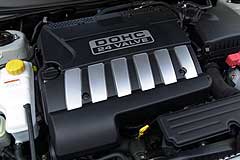
Engine Performance
The Verona is powered by a 2.5-liter, in-line 6-cylinder, 24-valve Dual Overhead Cam engine. It develops 155-horsepower at 5,800 RPM and 177 lb.-ft. of torque at 4,000 RPM. Verona is the least-expensive import to come standard with a V-6 engine. However this is not really powerful enough for Verona's size. The engine is transverse mounted -- meaning it sits in the engine bay sideways -- allowing for more cabin space given this is a smaller wheelbase vehicle.
Power goes to the front drive wheels through a 4-speed, electronically-controlled, automatic transmission. It has a gated shifter. This means there are jogs in the gear selector holding the shifter in place.
The engine is smooth and quiet, but it is a bit short on performance. The car could easily use 20 more horsepower for accelerating onto highways or heading up hills. We tried to get ahead of an 18-wheel truck getting onto a highway. We made it, but just barely. With a little more power drivers would feel more confident when accelerating. And this is a safety matter afterall, as often one has to choose to speed away from a problem, not just brake.
Ride and Handling
Verona's ride is quiet and smooth competing easily with those of the Hyundai Sonata and Kia Optima, its benchmark competition. It should also give the manufacturers of some of the more expensive sedans cause for concern. It is quiet and smooth.
The pleasant ride is due to the use gas filled shock absorbers and a Macpherson strut front suspension. This is similar to those found on more expensive sedans like the Saab 9-3 and Volvo S80. Verona also has a multilink rear suspension.
The front anti-sway bar is strong enough to prevent the car from having too much body roll in turns. It feels secure in corners are fairly high speeds. The anti-sway bar gives it more than adequate handling in a very inexpensive package.
Verona comes equipped with speed sensitive steering. This type of steering system is used to make it easier to steer the vehicle at slow speeds. This is particularly useful getting in and out of tight paring spots and maneuvering in traffic. It also increases steering stiffness at higher speeds, particularly on the highway, to give the driver more road feel.
Four-wheel disc brakes are standard on the Verona. We much prefer them to the front-disc, rear-drum brake combinations that are standard on the much more expensive competitors like the Honda Accord and the Toyota Camry. On these vehicles front and rear-disc brakes are expensive options. Given that better brakes are important to have on vehicles with six cylinder engines, we think Suzuki provides the appropriate combination.
Safety
The Suzuki Verona comes with most of the safety features one would expect to find in a car in this category. There are dual-stage front airbags for the driver and front passenger. However there are neither front-passenger side airbags nor a head curtain available. This is disappointing as they are standard, or optional, on some of the competitive vehicles.
There are front and rear, side-impact door beams to prevent intrusion into the passenger compartment. Verona comes standard with four-channel Anti-Lock brakes with Electronic Brake Force Distribution. These are optional on the Hyundai Sonata and Kia Optima.
No crash test data is yet available.
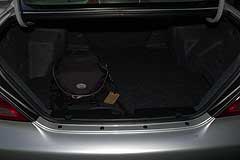
In Conclusion
The 2004 Suzuki Verona is a solid contender in the low price, 6-cylinder sedan market. Along with the up coming Forenza compact sedan, Verona will aid Suzuki in reaching its aggressive expansion plans. Suzuki vehicles are both reliable and a good value. Because they are often overlooked by car shoppers deals abound.
The Italian design of Verona is more appealing than those of the Hyundai Sonata and considerably more attractive than the Kia Optima ˆ both of which have design cues that are supposed to make the vehicles more upscale but end up confusing their looks.
If a Hyundai, Kia, Honda or Toyota are on your test drive list, make sure to get behind the wheel of a 2004 Suzuki Verona as well. You‚ll be pleasantly surprised.
More Data
Where Built: GMDAT Korea.
Major Options: Traction Control System.
Seating: 5
Number of Rows: 2
Length in Inches: 196.6
Warranties: 7 years/100,000 limited warranty, 3 years/36,000 limited powertrain warranty, 3 years/ 36,000 miles free roadside assistance.
Weight in Pounds: 3,893.
Maximum Payload in Pounds: Not Available.
Maximum Gross Vehicle Weigh in Pounds: Not Available.
Towing Capacity in Pounds: 3,380.
Gas Tank Capacity in Gallons: 117.2.
Destination Charge: $500




